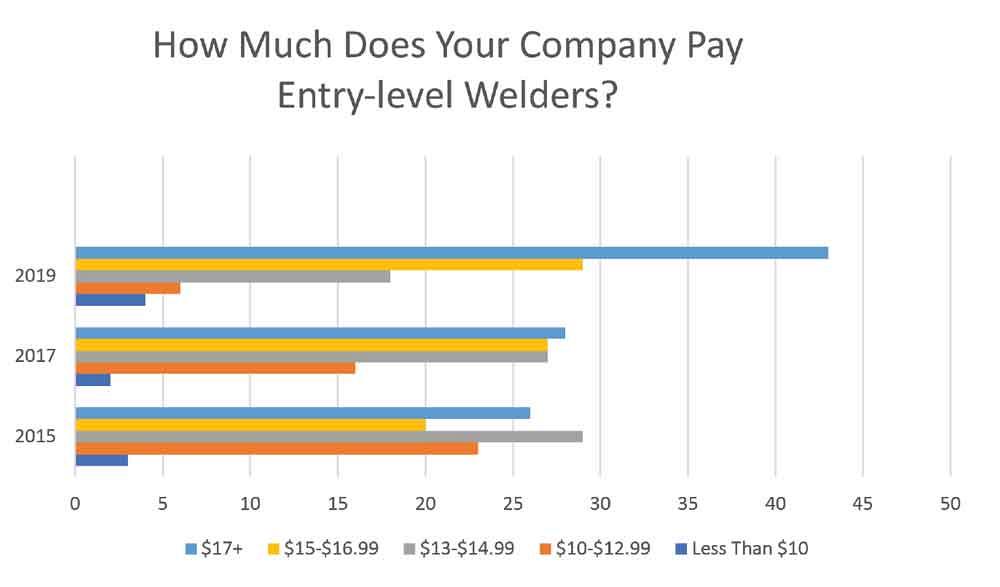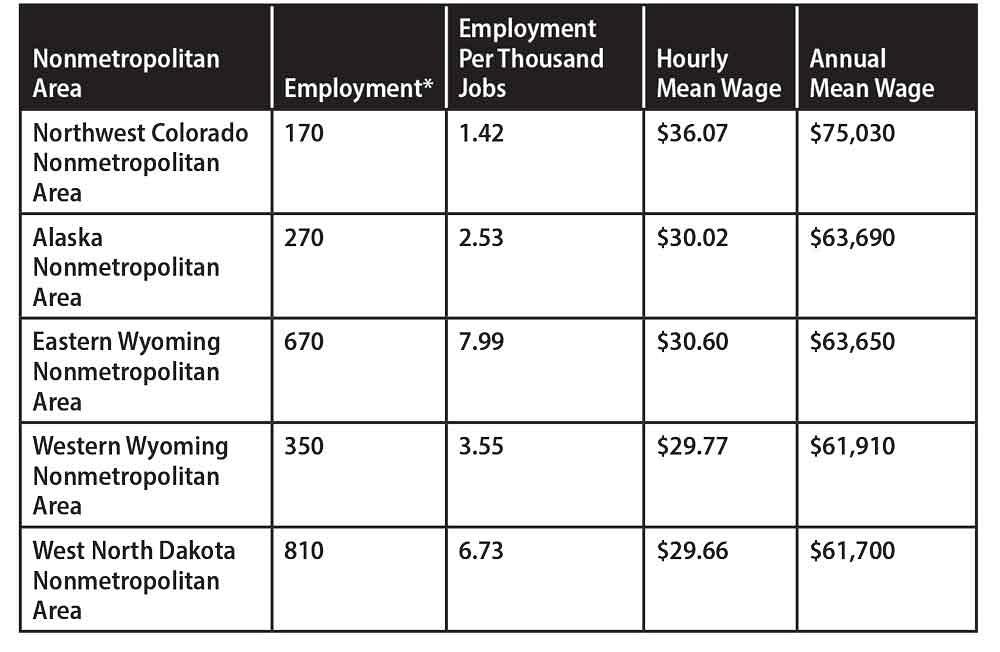Editor-in-Chief
- FMA
- The Fabricator
- FABTECH
- Canadian Metalworking
Categories
- Additive Manufacturing
- Aluminum Welding
- Arc Welding
- Assembly and Joining
- Automation and Robotics
- Bending and Forming
- Consumables
- Cutting and Weld Prep
- Electric Vehicles
- En Español
- Finishing
- Hydroforming
- Laser Cutting
- Laser Welding
- Machining
- Manufacturing Software
- Materials Handling
- Metals/Materials
- Oxyfuel Cutting
- Plasma Cutting
- Power Tools
- Punching and Other Holemaking
- Roll Forming
- Safety
- Sawing
- Shearing
- Shop Management
- Testing and Measuring
- Tube and Pipe Fabrication
- Tube and Pipe Production
- Waterjet Cutting
Industry Directory
Webcasts
Podcasts
FAB 40
Advertise
Subscribe
Account Login
Search
How much do welders make? The truth on welder salary
Entry-level welders won’t get rich right away, but a wealth of opportunities await
- By Dan Davis
- Updated January 27, 2023
- November 6, 2019
- Article
- Arc Welding
With any shortage, you expect costs to rise. It’s simple economics: If something is in demand and there’s not enough to go around, consumers can expect to pay more than what they might have had to pay when demand was less or more was available.
That’s left more than a few welders scratching their heads over the past several years as the industry continually beats the drums of a shortage of workers. The American Welding Society believes that the U.S. industry will have a shortage of more than 450,000 skilled welders by 2022. That’s quite a shortage. (The Bureau of Labor Statistics reports that almost 425,000 welding jobs existed in 2018.) In fact, someone might look at it as a moment when wages should be increasing in anticipation of this epic shortfall.
Exacerbating the situation are talking heads and the internet. Listen to enough people and you might think the starting salary for a welder is $40,000. That amount is thrown around quite a bit, but it’s really the median salary. The BLS reports that the 2018 median salary for welders was $41,380 per year. (The median average means that 50 percent of the welders in the U.S. made less than that and 50 percent made more.) Then you have an editorial headlined “Welders Make $150,000? Bring Back Shop Class” that appeared in The Wall Street Journal in April 2014, and it lives on as propaganda to entice young people to enter the welder ranks even if the focus was on one type of welder and his specific skill set. And let’s not forget anyone that happens to type “underwater welder salary” into an internet search engine. If an underwater welder can make $300,000 in a year, surely a welder on terra firma can make half of that, right?
The reality of the situation is that a welder can make a decent living, even at the entry level, but he or she generally won’t be earning top dollars right off the bat. Like any job, most have to start at the bottom.
Also, wages are rising, but maybe not at the rate that equates to the hype surrounding the skilled worker shortage. The WELDER, a sister magazine to The FABRICATOR, asked its subscribers in its last three readership studies how much their companies pay entry-level welders per hour (see Figure 1). In 2015, only 26 percent paid more than $17 per hour. By 2017 that had climbed to 28 percent, and this year it was 43 percent.
Rob Abfall, chief operating officer, Amerequip Corp., a fabricator of custom equipment for the lawn, landscape, agricultural, and construction markets, said the company was turning away work in 2017 and early 2018 because it had difficulty attracting and retaining workers. It went from 125 employees in 2012 to 300 by 2017. One of the first steps it took later in 2018 to stabilize the workforce was to boost wages.
“We opened up the contract [with the International Association of Machinists and Aerospace Workers union] and gave more significant raises than what were built into the original contract,” Abfall said.
In addition to boosting starting wages to more than $15 per hour, Amerequip raised starting wages for welders to more than $18 per hour. That wage bump and an agreement to go to a weekend shift that paid employees, including welders, 40 hours for a 36-hour shift over a Friday, a Saturday, and a Sunday, really helped to stabilize the workforce, so management could focus on filling open production capacity and becoming more efficient to introduce new capacity.
That need to boost welder wages is not unique to Kiel, Wis., home of Amerequip. With Amazon opening distribution centers all over the U.S. and larger metropolitan areas moving to a $15 minimum wage, more fabricating companies have been forced to boost wages. As The WELDER’s readership survey suggested, companies have had to be aggressive in adjusting wages to attract entry-level workers.
Of course, this is only part of the story when it comes to welders and their pay. Let’s look at some more factors that determine what welders can expect to earn.

Figure 1
Over the past five years, the number of shops paying welders at least $17 per hour has risen dramatically.
Experience Impacts Welder Salary
The couple of times as a kid you played with your dad’s welding power source that he kept in the garage does not count as welding experience, or at least the kind that manufacturers are looking for. Having said that, it doesn’t keep people from believing that they are ready to hit the ground running as a welder.
Reality, however, has a way of setting the record straight. A welder has to put in the time under the hood if he or she wants to maximize the craft’s earning potential.
That doesn’t always fit with the stereotype of millennials, who now represent the largest generational group in the U.S. workforce (56 million), according to the Pew Research Center. They want the money right now, even if they might not have the experience or skills to justify it.
“Everybody talks about being an underwater welder, but they just want the pay of an underwater welder,” said Scott Mazzulla, president and CEO, Hobart Institute of Welding Technology in Troy, Ohio. “It’s just unrealistic expectations that fade quickly because reality soon sets in.”
Mazzulla said that the current job market is very strong. He pointed to the quit rate, the rate at which people quit a job usually to move to a higher-paying position, as evidence. The U.S. Labor Department reported in early October that the quit rate hit a postrecession high in July. Mazzulla said conversations he has had with Hobart Institute alumni back these reports up.
“They can get what they want from you today, or they could probably look for a dollar or more per hour elsewhere because the demand is so high,” he said.
Ryan Blythe, founder of the Georgia Trade School in Acworth, Ga., said after eight years of training welders at the private technical school, he’s starting to see what awaits welders who hone their craft over several years. It’s not unusual for successful alumni to be making $30 to $35 per hour.
“I’m noticing the graduates from four or five years ago are starting to buy houses and have kids,” Blythe said. “In many instances, their situations are a lot better than a lot of their contemporaries that went to college and are struggling.”
Again, those who work at their craft will be in a better place than those who don’t because the highly skilled welders will be able to remain employed in the event of an economic downturn, which will definitely happen again even if the U.S. hasn’t seen one in 12 years.
“When the market declines, more people are going to go to school to become welders. So companies that are needing maybe 30 welders today will only need about 20 when the economy is not as strong,” Mazzulla said. “So the competition to get those jobs is going to be at a higher level. What’s going to happen is that the poor to mediocre welders are going to continue to look for work because they don’t have the skill set to land those jobs.”

Figure 2
If you want to maximize your salary as a welder, you need to go where there aren’t that many welders or go where there is a need for a lot of welders. Source: Bureau of Labor Statistics for “Welders, Cutters, Solderers, and Brazers,” May 2018. *Jobs number does not include self-employed individuals.
Welding Pay Varies by Job
Have welding skills and are willing to travel? You can pocket a lot more dough than the guy working in the fab shop 10 miles down the road from his house.
Mazzulla said of the 2,500 open jobs available to Hobart Institute graduates from 400 different employers, a couple on the job board offered $40 an hour and an $85 per diem. It’s pipeline work, and the welding school graduates have to be willing to go where the work is.
That’s not unusual as specialized welding skills are going to garner higher wages than those that don’t require certifications. For instance, according to the Fabricators & Manufacturers Association’s 2019 Salar/Wage & Benefit Survey, a code welder working in the metal fabricating industry has a median salary of $53,000, which is higher than a welder with just two years of experience and who earns a median salary of $44,096.
Blythe mentioned that certain companies make it very clear what welders can make so that it’s not a mystery. He said Ingalls Shipbuilding in Pascagoula, Miss., spells out to welders that if they can pass a welding test for a certain level, they will earn a certain wage. With more experience, the welders can then take another skill test for an increase in pay.
Of course, wages differ according to geographic location (see Figures 2 and 3). Places like Alaska and North Dakota have some of the highest hourly wages for welders, but those economics are closely linked to jobs in domestic energy production—building, maintaining, and repairing pipelines and rigs. Other places, like Hawaii and California, also are in the top 10 states for highest hourly welder wages, but the cost of living in these places is much higher than in places such as the Deep South states.
Employers Will Pay Higher Welder Salary for Leaders
What is often not discussed or is dismissed by many involved in debating how much welders should be paid is that employers don’t just want warm bodies that can lay down a consistent bead. They need someone who is punctual, intellectually curious, and works well with others. There’s also that need to pass a drug test.
“Watching the evolution of our graduates from 2013 to now, employers, especially in fabrication shops, are looking for somebody who could be a shop manager or a foreman. They want someone that can climb the ladder,” Blythe said.
These employers want someone they can mold to be successful in their own manufacturing environment. When they find that right skilled worker, they should be interested in keeping him or her around. That’s a symbiotic relationship that should keep both employer and welder happy.
About the Author

Dan Davis
2135 Point Blvd.
Elgin, IL 60123
815-227-8281
Dan Davis is editor-in-chief of The Fabricator, the industry's most widely circulated metal fabricating magazine, and its sister publications, The Tube & Pipe Journal and The Welder. He has been with the publications since April 2002.
Related Companies
subscribe now

The Fabricator is North America's leading magazine for the metal forming and fabricating industry. The magazine delivers the news, technical articles, and case histories that enable fabricators to do their jobs more efficiently. The Fabricator has served the industry since 1970.
start your free subscription- Stay connected from anywhere

Easily access valuable industry resources now with full access to the digital edition of The Fabricator.

Easily access valuable industry resources now with full access to the digital edition of The Welder.

Easily access valuable industry resources now with full access to the digital edition of The Tube and Pipe Journal.
- Podcasting
- Podcast:
- The Fabricator Podcast
- Published:
- 04/16/2024
- Running Time:
- 63:29
In this episode of The Fabricator Podcast, Caleb Chamberlain, co-founder and CEO of OSH Cut, discusses his company’s...
- Trending Articles
AI, machine learning, and the future of metal fabrication

Employee ownership: The best way to ensure engagement

Steel industry reacts to Nucor’s new weekly published HRC price

Dynamic Metal blossoms with each passing year

Metal fabrication management: A guide for new supervisors

- Industry Events
16th Annual Safety Conference
- April 30 - May 1, 2024
- Elgin,
Pipe and Tube Conference
- May 21 - 22, 2024
- Omaha, NE
World-Class Roll Forming Workshop
- June 5 - 6, 2024
- Louisville, KY
Advanced Laser Application Workshop
- June 25 - 27, 2024
- Novi, MI




























